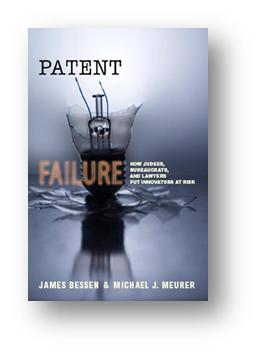 James Bessen and Michael J. Meurer have authored a new book presenting a careful empirical analysis of whether patent rights encourage innovation. Their conclusion: for the most part, today's patent system does not achieve its stated goal. I asked them to provide Patently-O readers with a cut from their analysis. The following post is the first in a series of four by the authors. The book is titled: Patent Failure and published by Princeton [Web Link]. The analysis done in this book put Bessen and Meurer at the forefront of leaders in economic analysis of patent laws. I suspect that their results will become the talking points of the next round of patent reform discussions. A live symposium will be held at UGA Law School on March 29 focusing on the book and its results. [LINK]
James Bessen and Michael J. Meurer have authored a new book presenting a careful empirical analysis of whether patent rights encourage innovation. Their conclusion: for the most part, today's patent system does not achieve its stated goal. I asked them to provide Patently-O readers with a cut from their analysis. The following post is the first in a series of four by the authors. The book is titled: Patent Failure and published by Princeton [Web Link]. The analysis done in this book put Bessen and Meurer at the forefront of leaders in economic analysis of patent laws. I suspect that their results will become the talking points of the next round of patent reform discussions. A live symposium will be held at UGA Law School on March 29 focusing on the book and its results. [LINK]
==========
by James Bessen and Michael J. Meurer
As background material, this post reviews the sizable body of empirical research analyzing the impact of patents on R&D investment and economic growth. Three future posts will present new empirical research featured in our book Patent Failure. The theme across all four posts is that patents often fail to perform effectively as property rights. [DDC: To work well as property, the right should be predictably valid; have discernible boundaries; and not have an overly fragmented ownership scheme.]
Economists cherish property rights that provide strong incentives for investment and trade, and that thereby contribute to economic growth. Potentially, patent rights could accomplish these three goals, and surely they sometimes do. Apparently though, it is hard to set up and maintain a patent system that works as property.
The rise of new market economies and strengthening of property rights around the globe in the last two decades provides economists with "natural experiments" that help us evaluate whether and how much property rights contribute to investment and growth. The empirical results are impressive. Countries that expanded the role of markets and strengthened property rights have prospered from these choices. Economic historians find the same results hold going back to the Industrial Revolution.
Comparable studies of patent systems are discouraging. The evidence certainly is consistent with the notion that patents encourage American pharmaceutical R&D. But otherwise, it is hard to find evidence suggesting patents are a major factor spurring R&D investment, that patents contribute to economic growth, or even that the patent system is a source of great wealth to important inventors and innovators (outside of a few industries like pharmaceuticals).
To continue reading, become a Patently-O member. Already a member? Simply log in to access the full post.